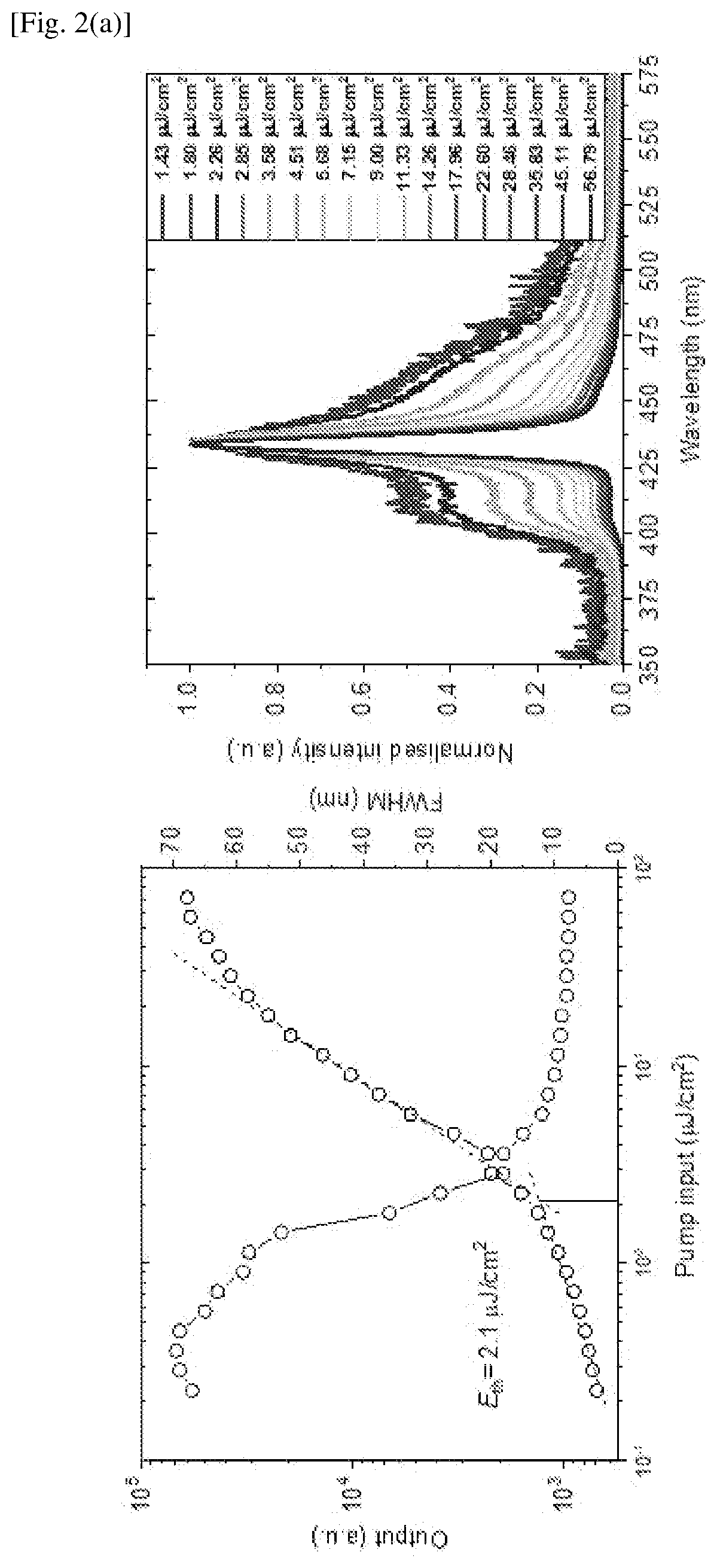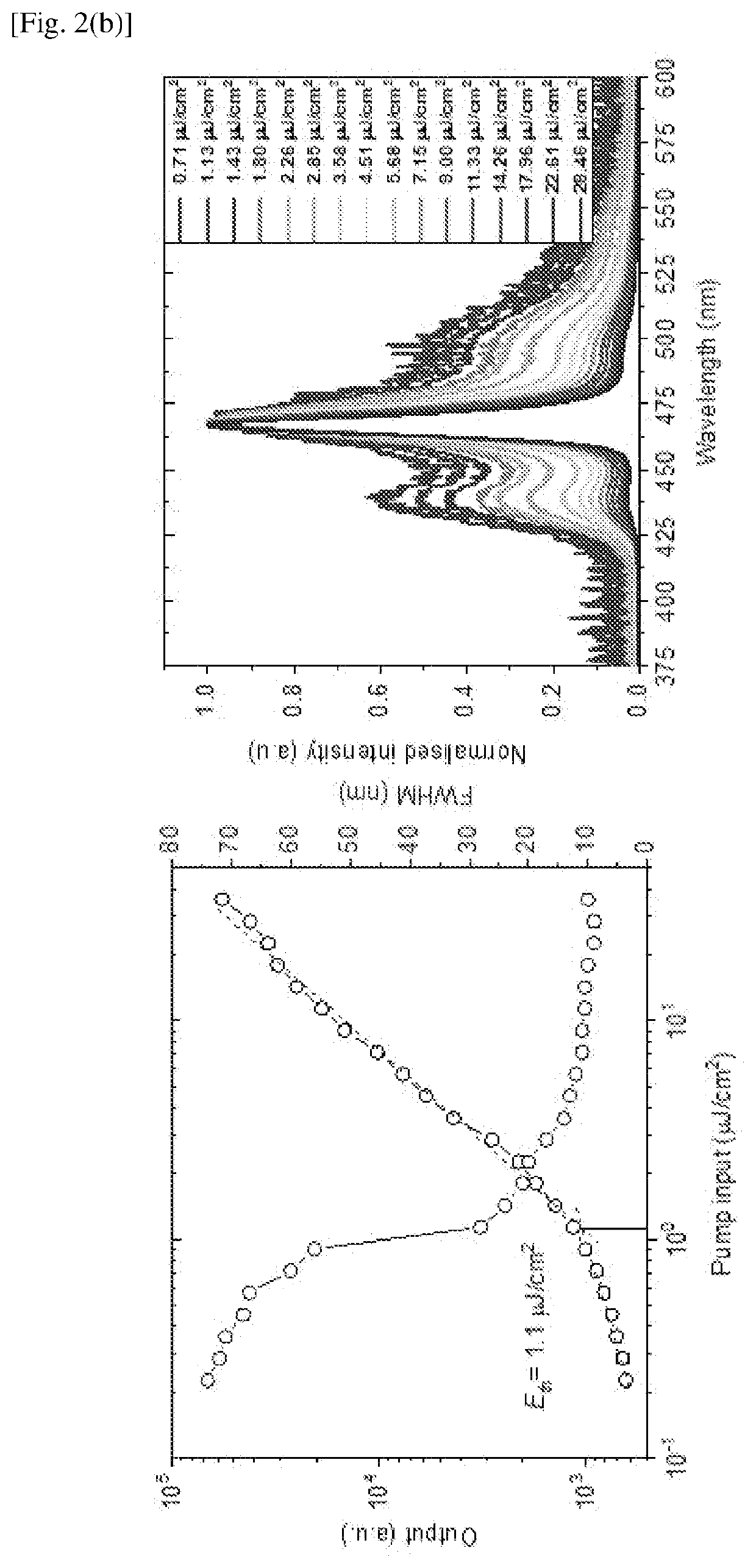Compound, organic semiconductor laser and method for producing same
- Summary
- Abstract
- Description
- Claims
- Application Information
AI Technical Summary
Benefits of technology
Problems solved by technology
Method used
Image
Examples
synthesis example 1
(E)-9-(4-(2-(9,9-dihexyl-9H-fluoren-2-yl)vinyl)phenyl)-9H-carbazole, SFCz
[0074]A mixture of 9-(4-Vinylphenyl)-9H-carbazole (383 mg, 1.42 mmol), 2-Bromo-9,9-dihexyl-9H-fluorene (531 mg, 1.29 mmol), tri(o-tolyl)phosphine (34.9 mg, 0.115 mmol), palladium(II) acetate (8.0 mg, 0.036 mmol) and triethylamine (3.0 mL) was dissolved in anhydrous dimethylformamide (6.0 mL). The solution was quickly deoxygenated under vacuum and back-filled with Ar gas. This process was repeated 3 times. The reaction mixture was then stirred in a 90° C. oil bath under Ar gas for 4 hours. The mixture was cooled to room temperature. Water (50 mL) and diethyl ether (50 mL) were added to the mixture and the two layers were separated. The aqueous layer was extracted with diethyl ether (2×40 mL). All organic layers were combined, washed with water (3×70 mL), dried over anhydrous magnesium sulfate and filtered. The filtrate was collected and solvent removed under reduced pressure to give a yellow gummy solid. The cru...
synthesis example 2
9,9′-(((1E,1′E)-(9,9-dihexyl-9H-fluorene-2,7-diyl)bis(ethene-2,1-diyl))bis(4,1-phenylene))bis(9H-carbazole), BSFCz
[0075]A mixture of 9-(4-Vinylphenyl)-9H-carbazole (700 mg, 2.60 mmol), 2,7-Dibromo-9,9-dihexyl-9H-fluorene (510 mg, 1.04 mmol), tri(o-tolyl)phosphine (37.7 mg, 0.124 mmol), palladium(II) acetate (7.0 mg, 0.031 mmol) and triethylamine (4.0 mL) was dissolved in anhydrous dimethylformamide (11 mL). The solution was quickly deoxygenated under vacuum and back-filled with Ar gas. This process was repeated 3 times. The reaction mixture was then stirred in a 90° C. oil bath under Ar gas for 4 hours. The mixture was cooled to room temperature. Water (100 mL) and diethyl ether (100 mL) were added to the mixture and the two layers were separated. The aqueous layer was extracted with diethyl ether (100 mL). All organic layers were combined, washed with water (3×150 mL), dried over anhydrous magnesium sulfate and filtered. The filtrate was collected and solvent removed under reduced ...
synthesis example 3
9,9′-(((1E,1′E)-(9,9,9′,9′,9″,9″-hexahexyl-9H,9′H,9″H-[2,2′:7′,2″-terfluorene]-7,7″-diyl)bis(ethene-2,1-diyl))bis(4,1-phenylene))bis(9H-carbazole), BSTFCz
[0076]A mixture of 9-(4-Vinylphenyl)-9H-carbazole (603 mg, 2.24 mmol), 7,7″-Dibromo-9,9,9′,9′,9″,9″-hexahexyl-9H,9′H,9″H-2,2′:7′,2″-terfluorene (1.04 g, 0.897 mmol), tri(o-tolyl)phosphine (42.4 mg, 0.139 mmol), palladium(II) acetate (11.0 mg, 0.049 mmol) and triethylamine (5.0 mL) was dissolved in anhydrous dimethylformamide (22 mL). The solution was quickly deoxygenated under vacuum and back-filled with Ar gas. This process was repeated 3 times. The reaction mixture was then stirred in a 90° C. oil bath under Ar gas for 4 hours. The mixture was cooled to room temperature. Water (100 mL) and diethyl ether (100 mL) were added to the mixture and the two layers were separated. The aqueous layer was extracted with diethyl ether (70 mL). All organic layers were combined, washed with water (3×150 mL), dried over anhydrous magnesium sulfa...
PUM
 Login to View More
Login to View More Abstract
Description
Claims
Application Information
 Login to View More
Login to View More - R&D
- Intellectual Property
- Life Sciences
- Materials
- Tech Scout
- Unparalleled Data Quality
- Higher Quality Content
- 60% Fewer Hallucinations
Browse by: Latest US Patents, China's latest patents, Technical Efficacy Thesaurus, Application Domain, Technology Topic, Popular Technical Reports.
© 2025 PatSnap. All rights reserved.Legal|Privacy policy|Modern Slavery Act Transparency Statement|Sitemap|About US| Contact US: help@patsnap.com



